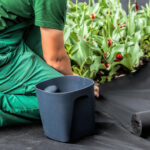Geotextiles are unique fabrics used to manage soil in agriculture and to control erosion in different environments. These fabrics come in two types: woven and non-woven, each with its own benefits for specific needs. This post will compare woven and non-woven geotextiles to help you understand which type might be best for your projects, focusing on their effectiveness in agricultural applications and erosion control.
What are Geotextiles?
Geotextiles are special fabrics used to solve problems in construction and landscaping. Think of them as a strong layer that helps control the ground. They keep the soil in place, help water move through without washing the soil away, and even keep different layers of materials separate. This makes them very important for building safe and strong structures.
Geotextiles are used in many areas, not just big construction projects. They can be found in small garden projects, erosion control, Agriculture, drainage systems.
Most geotextiles are made from synthetic materials like polypropylene. These materials are chosen because they can handle wet conditions, don’t wear out easily, and are strong enough to hold back soil and water. Using the right materials means that geotextiles can do their job well
Understanding Woven Geotextiles
Woven geotextiles, robust fabrics crafted by interlacing synthetic fibers, resemble traditional cloth in their manufacturing process. These fabrics are renowned for their strength, stability, and longevity. They find extensive use in projects demanding additional ground support, such as agriculture, landscape preservation, and erosion control. Their endurance makes them a popular choice for challenging environments where soil stabilization is paramount.
Manufacturing Process
Manufacturers use large machines that weave synthetic fibers like polypropylene to make woven geotextiles. These fibers are crossed over and under each other in a pattern, forming a tight and strong network. This fabric-making method ensures that it can hold up under tough conditions.
Key Properties
The main strengths of woven geotextile fabrics are their high strength, stability, and durability. They are designed to be very strong, meaning they can hold much weight without breaking. Once installed, they also stay in place, providing a stable and reliable foundation for any project. Plus, they last a long time even when exposed to harsh environments.
Common Applications
Woven geotextiles are widely used in several critical areas:
- Agriculture: In farming, woven geotextiles stabilize soil and manage water drainage, helping maintain soil structure and ensure that crops receive adequate water without waterlogging.
- Soil Stabilization: Essential in construction and landscaping, woven geotextiles reinforce soil, preventing it from shifting and eroding. This is particularly important in areas with loose soil that might otherwise collapse under structural weight.
- Drainage Systems: Woven geotextiles are used in drainage applications. Their strength helps hold the earth in place while allowing water to filter through, preventing drainage systems from clogging with sediment.
- Landscaping: In landscaping, woven geotextiles are used to separate soil layers, improve ground stability, and manage erosion, particularly in decorative flower beds and paths where soil separation is crucial.
- Silt Fencing: Woven geotextiles, utilized primarily in construction sites, serve as silt fences to control sediment runoff. They act as barriers to trap sediment while allowing water to pass through, preventing sediment from entering natural waterways and complying with environmental regulations.
- Weed Control: Woven geotextiles are also effective in weed control. They act as a barrier that prevents weeds from growing by blocking sunlight while still permitting moisture to reach the soil, thus preserving soil health and cleanliness in landscaped areas.
These applications highlight how woven geotextiles contribute to more stable and sustainable environmental and agricultural projects.
Understanding Non-Woven Geotextiles
Non-woven geotextiles are made by bonding fibers together, not by weaving. This results in a fabric that feels like felt and is adaptable for various uses.
- How Are They Made: They are usually made by needle-punching or heat-bonding. Needle-punching tangles fibers together mechanically, while heat-bonding melts fibers together.
- Key Characteristics:These geotextiles are permeable, flexible, and have strong filtration abilities. They allow water to pass while blocking soil, supporting flexibility for uneven surfaces.
- Where Are They Used: Non-woven geotextiles are essential in construction for drainage systems and landscaping, helping to prevent soil erosion and improve water flow, and in road construction for ground stabilization.
Comparing Woven and Non-Woven Geotextiles
This section will explore the differences between woven and non-woven geotextiles. We’ll examine their durability, cost-effectiveness, suitability for different projects, and what to consider during installation and maintenance.
Durability
When it comes to durability, woven geotextiles generally offer superior strength and longevity compared to non-woven geotextiles. The tightly woven structure of these fabrics provides a robust barrier against mechanical stresses, making them highly resistant to wear and tear. This characteristic makes woven geotextiles particularly effective for applications requiring a high degree of stabilization and durability, such as in erosion control and soil reinforcement, where they outperform non-woven alternatives. Additionally, our woven geotextile fabrics are reusable, enhancing their sustainability and providing further economic benefits by allowing multiple uses in various projects. The longevity and resilience of woven geotextiles remain effective over long periods, even under challenging environmental conditions.
Cost-effectiveness
Woven geotextiles are often more cost-effective compared to non-woven geotextiles, especially for projects requiring long-term durability and strength. The initial investment in woven geotextiles might be higher, but their extended lifespan and reduced need for maintenance or replacement make them a more economical choice in the long run. Their robust construction means that woven geotextiles are less likely to suffer damage during installation and use, which translates to lower overall costs for large projects like Landscaping and soil stabilization. This makes woven geotextiles an attractive option for projects where budget and long-term performance are key considerations.
Application Suitability
When it comes to durability, woven geotextiles generally offer superior strength and longevity compared to non-woven geotextiles. The tightly woven structure of these fabrics provides a robust barrier against mechanical stresses, making them highly resistant to wear and tear. This characteristic makes woven geotextiles particularly effective for applications requiring a high degree of stabilization and durability, such as in erosion control, Landscaping and soil Stabilization, where they outperform non-woven alternatives. The longevity and resilience of woven geotextiles remain effective over long periods, even under challenging environmental conditions.
Installation and Maintenance Considerations
Woven geotextiles often present advantages in installation and maintenance over non-woven geotextiles, especially in demanding environments. Their robust woven structure makes them more resilient during the installation process, reducing the risk of tears and punctures. This ease of installation, coupled with their durability, translates into lower maintenance requirements. Woven geotextiles are less likely to degrade or need replacement, offering a more efficient and trouble-free solution for projects requiring long-term stability and minimal maintenance than non-woven alternatives.
In summary, while both types of geotextiles have distinct advantages, woven geotextiles often offer superior durability and cost-effectiveness for projects requiring robust reinforcement. Choosing the right type depends on the project’s specific needs and conditions.
Advantages and Disadvantages
In this section, we’ll explore the benefits and limitations of both woven and non-woven geotextiles. We’ll discuss their strengths and weaknesses to help determine which type might best suit specific construction scenarios.
Woven Geotextiles Pros
- High Strength: Woven geotextiles, such as those produced by Anita Plastics, are incredibly strong, making them ideal for use in situations where the soil needs a lot of support.
- Durability: They are highly durable and resistant to degradation, which means they last a long time, even under tough environmental conditions. Also, they are reusable.
- Cost-Effective: Over time, the durability and strength of woven geotextiles can lead to lower maintenance and replacement costs, making them a cost-effective choice for large-scale projects.
Woven Geotextiles Cons
- Less Permeable: Woven geotextiles are less permeable than non-woven types, which can be a drawback in projects requiring significant drainage.
- Flexibility: They are less flexible than non-woven fabrics, which might limit their use in applications requiring molding around irregular shapes.
Non-Woven Geotextiles Pros
- Excellent Filtration: Non-woven geotextiles filter soil particles from water, making them perfect for drainage systems.
- Flexibility: They conform easily to the ground and irregular surfaces, which is helpful in landscape and erosion control projects.
Non-Woven Geotextiles Cons
- Lower Load Capacity: They generally have a lower load-bearing capacity than woven geotextiles, which can limit their use in heavy-duty applications.
- Durability: Non-woven geotextiles might not be as suitable for applications where high tensile strength and durability are crucial.
Woven geotextiles are often the better choice for projects requiring high durability and strength. They ensure long-lasting performance, essential in many infrastructure projects, making them a reliable and economical solution in the construction industry.
This post compares the characteristics, applications, and pros and cons of woven and non-woven geotextiles. Anita Plastics Woven geotextiles, known for their strength and durability, are ideal for heavy-duty applications like road construction and soil stabilization. Non-woven geotextiles excel in drainage and filtration tasks, making them suitable for erosion control and landscaping. When selecting the right geotextile for your project, consider the specific requirements of the job and the environmental factors involved.
For projects demanding high durability and strength, consult with experts at Anita Plastics, the best woven geotextile fabric manufacturer. Explore our products and gain more insights by visiting our website. Make informed decisions with the right guidance to ensure the success of your construction projects.




